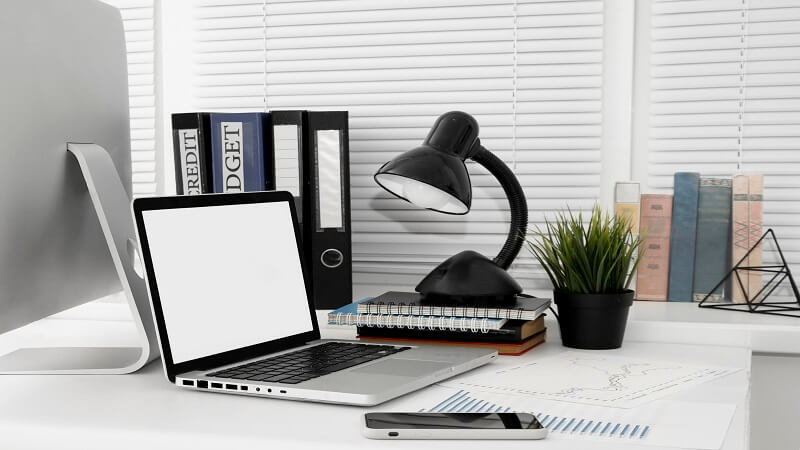Minimalist desk setups refer to organizing your workspace with only the essentials and decluttering unnecessary items. These setups focus on simplicity and functionality, aiming to create a clean and efficient workspace. By adopting a minimalist approach, individuals can enjoy several benefits. Firstly, it promotes productivity by reducing distractions and allowing for better focus on the tasks at hand. Secondly, it enhances mental clarity and reduces stress by creating a calm and uncluttered environment. Additionally, minimalist desk setups can save space and promote better posture by eliminating unnecessary clutter and promoting ergonomic furniture choices. In this blog, we will explore various tips and strategies for creating a minimalist desk setup, including decluttering techniques, ergonomic furniture options, and organization hacks to optimize your workspace for productivity and well-being.
The Psychology of Minimalism
Minimalism, in psychology, means simplifying things to their essentials. It’s about focusing on what truly matters and removing unnecessary distractions. By embracing minimalism, you streamline your life, which can lead to increased productivity. When your surroundings are clutter-free, your mind can concentrate better. Clutter can overwhelm your brain, making it hard to focus and causing stress. Minimalism helps clear away this mental clutter, allowing you to think more clearly and be more productive. So, by adopting minimalist principles, you’re not just decluttering your physical space; you’re also decluttering your mind, which can have a positive impact on your overall well-being
Essential Elements of a Minimalist Desk Setup
Crafting a minimalist home desk setup revolves around four essential elements. First, selecting the right desk lays the foundation. Opt for a clean-lined, functional desk that suits your space and workflow needs. Second, prioritize ergonomic furniture to promote comfort and posture support during long hours of work. Invest in a supportive chair and consider adjustable components like monitor stands to customize your setup. Third, employ organizational tools to declutter and streamline your workspace. Utilize trays, bins, and cable management solutions to maintain a tidy environment. Finally, incorporating natural elements such as plants or natural light can enhance creativity and productivity. Integrate greenery for a touch of freshness and position your desk near windows to maximize exposure to natural light. By integrating these elements, you can cultivate a minimalist desk setup conducive to focus and efficiency.
Streamlining Your Tech
When it comes to streamlining your tech setup, there are a few straightforward ways to make things run smoother. First off, optimizing your computer setup is a good starting point. This means making sure your hardware and software are up to date, organizing your files efficiently, and keeping unnecessary programs to a minimum to avoid slowing things down. Another aspect to consider is reducing cable clutter. By using cable management solutions like cable clips or zip ties, you can keep your workspace tidy and minimize the risk of tripping over wires. Lastly, opting for minimalist peripherals and accessories can help declutter your desk and simplify your workflow. This could mean investing in a wireless keyboard and mouse combo, or choosing a single monitor with built-in speakers instead of multiple separate devices. By implementing these strategies, you can streamline your tech setup and optimize your productivity.
Personalization and Functionality
Too much clutter can hinder focus, while too little personalization can make the space feel sterile. By strategically adding meaningful decorations, such as photos, plants, or motivational quotes, you can infuse your workspace with personality without sacrificing simplicity. These touches should be carefully selected to enhance rather than detract from the functionality of the space. Additionally, tailoring your workspace to your specific work style is crucial. Consider factors such as lighting, organization systems, and ergonomic furniture to create a space that supports your workflow. Whether you thrive in a quiet, zen-like environment or prefer a more vibrant and dynamic atmosphere, your workspace should reflect and accommodate your unique needs. By striking the right balance between minimalism and personalization and optimizing functionality to suit your work style, you can create a productive workspace with less clutter and more focus.
Tips for Maintaining a Minimalist Workspace
Creating and sustaining a minimalist workspace involves a few key strategies. Firstly, develop regular decluttering habits. Set aside time each week or month to assess your workspace and remove any items that are not essential. This prevents unnecessary accumulation and keeps your workspace clean and organized. Secondly, avoid unnecessary purchases. Before buying new items, consider if they truly add value to your workspace. Investing in quality, multifunctional items can reduce the need for additional clutter. Lastly, implement a “one in, one out” rule. For every new item you bring into your workspace, remove an existing one. This helps maintain a balanced and clutter-free environment, ensuring that your workspace remains efficient and conducive to productivity. By incorporating these tips into your routine, you can create a minimalist workspace that promotes focus and creativity.
Conclusion
In conclusion, minimalist desk setups offer a practical approach to organizing workspaces by focusing on simplicity and functionality. The benefits are clear: increased productivity, reduced stress, improved posture, and enhanced creativity. To create a productive workspace with less, prioritize ergonomic furniture, utilize organizational tools, and integrate natural elements. Streamlining your tech setup and personalizing your space is also crucial for maintaining a balance between minimalism and functionality. Developing regular decluttering habits, avoiding unnecessary purchases, and implementing a “one in, one out” rule are key strategies for sustaining a minimalist workspace. Embracing minimalism clears away mental clutter to enhance focus and overall well-being. By embracing these principles, you can optimize your workspace for greater efficiency and creativity.
